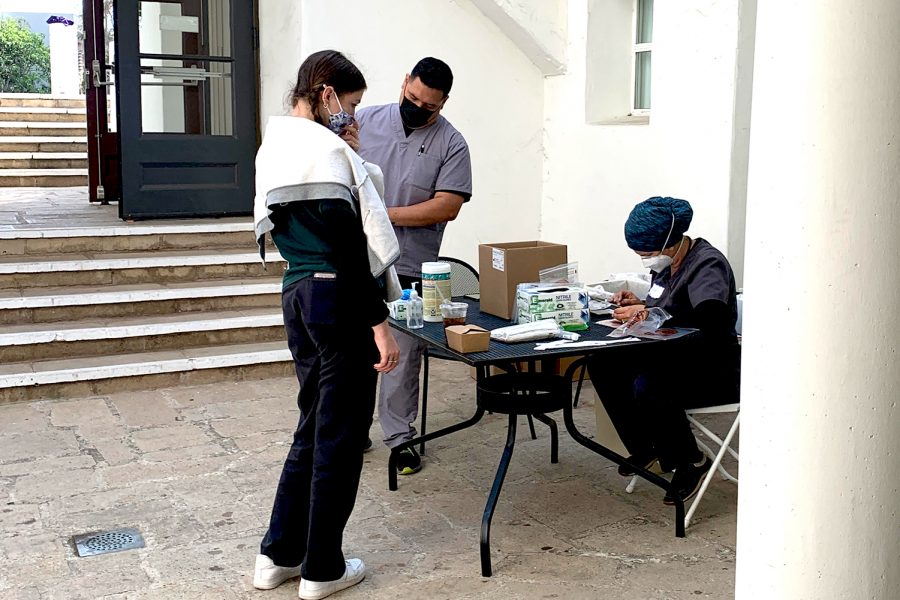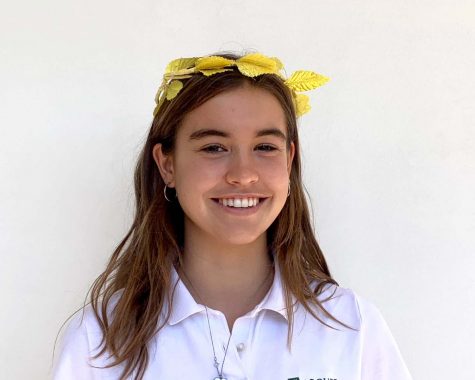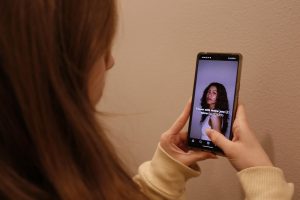Safety first: COVID-19 protocols and policies implemented for the 2021-2022 school year
Photo credit: Greta Irvine
A student waits to get her PCR COVID-19 test in the library courtyard on The testing program, previously done with Laboratory Services of America and now with Innovative Health Diagnostics, is one measure taken to limit community exposure to COVID-19. On Oct. 6, the community will be transitioning to weekly COVID-19 testing for all students, faculty and staff as opposed to the biweekly testing for vaccinated community members.
October 2, 2021
It’s a cool, late September morning: you pack your binders in your backpack, eat breakfast with your family, brush your teeth and put on your uniform. But you’re not ready to go to school because this year, your checklist has gotten longer. You take your temperature, submit your symptom screening, grab a mask and now, you are ready for the school day.
As the 2021-2022 school year began, Archer administration instituted new COVID-19 health and safety protocols and policies in the community. Senior administrative committees at Archer worked in concert with public health officials to develop protocols — such as mandating student vaccination, masking and health screenings — to limit the community’s exposure to COVID-19.
“The way we organize the school and make it run every day has to ensure people’s safety to the fullest extent possible,” Head of School Elizabeth English said. “We know that kids need to be in school; it’s a health risk to not have kids in school. Last year was really really difficult for our students, especially in terms of their mental health and their academic progress. So, we want to do everything we can to keep the school open.”
Vaccination Policy
A chief element of ensuring the safety of the student body, faculty and staff was the administration’s decision to require all eligible community members to get vaccinated against COVID-19. English announced the school-wide policy in an email to Archer families in early August, citing a “renewed caution” that is required of the community due to the emergence of the Delta variant.
School leaders follow guidelines from the Los Angeles County Department of Public Health. However, the department did not require a vaccination mandate. That decision was at the discretion of the head of school.
“My job…is to make sure that when we have a decision to make that isn’t completely mandated — at the end of the day, in consultation with not only Ms. Davis but other members of the senior admin team — I make a good decision for the school,” English said. “A good example of that is the vaccine mandate. It seemed very clear to me that that was a reasonable expectation given what we’re dealing with, especially with the Delta variant.”
To attend school in the fall, eligible community members had to be fully vaccinated before Friday, Sept. 10, 11 days into the school year. A person is considered to be fully vaccinated two weeks after their second dose in a two-dose series of the Pfizer or Moderna shot or two weeks after receiving the single-dose vaccine, Johnson & Johnson. While a number of students received the vaccine in the earlier months of 2020, those who had not yet gotten vaccinated had to do so within the month.
Students under the age of 12 cannot yet get vaccinated due to FDA vaccination eligibility requirements. To accommodate those in sixth and seventh grade who remain unvaccinated, the grades must follow specialized safety protocols. Once students become age-eligible, they have eight weeks from their 12th birthday to get fully vaccinated.
“We make our decisions based on facts and science, and the vaccine has been effective, and masking has been effective. So what we’re looking at is what is protecting the greatest number of people,” English said. “We also have sixth and seventh graders who need to be protected and reasonably assured that we’re doing everything we can… I just felt like the vaccination was, for me, a no-brainer.”
Community members who had concerns about the vaccination policy or wanted to request an exemption from the COVID-19 vaccine could contact Healthcare and Safety Practitioner Amanda Butch. However, as a whole community, there was little pushback about the policy and a reassuring compliance, English said.
“We were fortunate we’re a pretty rational community. Quite frankly, as a leader, sometimes you have to make the hard call when people are [pushing] back that this is what we’re doing for the benefit of the community. And if you’re not on board with it there may be other schools where it’s optional [to get vaccinated],” English said. “This seemed to me like one of those decisions where you’re either with us or you’re not and that’s okay.”
COVID-19 Communication
Archer leaders remain in weekly contact with the Los Angeles County Department of Public Health, who advises the school on health and safety protocols and mandates. A main source of contact is Dr. Barbara Ferrer, a nationally-known public health leader, who currently directs the agency.
“Dr. Barbara Ferrer…is very transparent in what’s happening with the virus and changes that [the LADPH] is making. It’s weekly, and things change very rapidly,” Associate Head of School for Finance & Operations Jane Davis said.
English also receives guidance regarding COVID-19 protocols in the school environment from deliberations with other schools, both those that align with and diverge from the protocols in place at Archer.
“I’m always consulting with other heads of schools — there’s a regular call,” English said. “Not every head made the choice [to mandate vaccines] but most in our cohort have at this point. There are other schools throughout California where that hasn’t been the choice, and that’s their prerogative.”
The Los Angeles Unified School District, the second largest public school district in the nation, serving hundreds of thousands of students, enacted a vaccination mandate in September. The mandate requires all students 12 years of age and older to be vaccinated by January 2022. This is one example of the growing number of schools moving towards vaccination mandates nationwide.
As a Los Angeles school, Archer must abide by the rules set by the department of health, which tend to fall on the more cautious side in comparison to general state-imposed rules. Along with the department’s required mandates, Archer has taken extra precautions by laying down additional protocols for the community.
“The Los Angeles Department of Public Health trumps the state and trumps the CDC, and they tend to be much more conservative than the state or CDC. There’s lots of reasons for that — some of it is because of community transmission in Los Angeles,” Davis said. “We have to do what they mandate, but then sometimes we’re going a step above that if we feel like that’s in the best interest of the community.”
COVID-19 Protocols
The COVID-19 Policies and Protocols section of the 2021-2022 Archer Handbook outlines the prevention and mitigation measures students and parents must follow throughout the school year. As written in the document, the policy was developed in consultation with guidance from the Centers for Disease Control and Prevention, the California Department of Public Health, the Los Angeles County Department of Public Health and other local, state and national entities.
On a day-to-day basis, community members must abide by the following protocols: physical distancing of at least 3 feet and, ideally, 6 feet whenever possible, submitting a symptom screening prior arriving at campus via the Titan app and masking at all times, barring eating and drinking. The masking rules currently in place go beyond the department of health’s mandates.
“[The] mask mandate outside, for example, was not something that the county expected us to do, but because we have some sixth and seventh graders who are unvaccinated, it seemed prudent,” English said. “Nobody likes living with this thing on their face — I complain about it regularly — and we want to get rid of it, but just not enough people are vaccinated and [there are] breakthrough infections. So we’re just not out of the woods yet.”
As the local and global environment continues to shift in regards to the state of the pandemic, Archer mandates and protocols are subject to change.
“An example of where we pivoted [was] when we were at the beginning of school opening, and we had thought that people could have no masks outside,” Davis said. “As we saw the numbers kick up, we realized that was just not going to be appropriate. So that’s an example of going through the science.”
Other protocols outlined in the handbook cover quarantining and traveling for both unvaccinated and vaccinated students, on campus visitor restrictions, actions to be taken when developing illness at school and managing behavior during meal periods. Additionally, when a student returns to campus after experiencing COVID-19 symptoms, receiving a positive COVID-19 test result or having a close contact exposure, parents must sign a specific certificate, as listed in the handbook.
Additional safety steps include maintaining ventilation and filtration systems, increasing air circulation by opening windows and doors to the extent possible and posting informational signs around campus, which instruct students, parents and other visitors not to enter campus if they are experiencing symptoms associated with COVID-19.
“We have a four-person committee that is meeting way more than we ever thought we would…talking through all of the various things like protocols and the changing guidance from the Los Angeles Department of Public Health,” Davis said. “We are constantly looking at what we’re doing and pivoting and making changes and listening to constituent’s concerns. As conditions change, we have to change.”
PCR COVID-19 testing is a final, imperative component of Archer’s health and safety protocols. In the initial weeks of the school year, each student was required to get tested biweekly on campus by setting up an appointment with Laboratory Services of America. However, as the school leaders were “monitoring local COVID-19 statistics and recalibrating [their] policies as conditions chang[ed],” English wrote in an email to families, starting Sept. 8, all unvaccinated students were required to get tested weekly.
On Sept 30, Davis informed families of another update to testing protocols that will go into effect Oct. 6. Testing will now be done through Innovative Health Diagnostics and all students, faculty, and staff must get tested weekly.
“We base everything on conditions,” English said. “So, last spring, we were testing weekly…and then the virus started—we thought it diminished, so we moved to biweekly testing. That’s an example of how we adjusted our testing protocol, but things are constantly changing.”
Current Conditions and Looking Forward
In the first month of the 2021-2022 school year, two members of the Archer community tested positive for COVID-19. Archer parents received email communication from the school informing them of the community cases and the precautions being taken by the school. The student body, however, did not receive communication on the situation. Sending an email to the students was not discussed, English said, as “our obligation is to let parents know first and the employees.”
“There are developmental stages that one goes through between sixth grade and 12th grade, so there’s some of that to be weighed. I wouldn’t send that email to a sixth grader or seventh grader or even eighth grader, frankly, because the level of panic and the inability for kids at that age to assess risk,” English said. “This is going to happen at sports games, at social events — and it’s scary. So the decision there was that parents can help their kids process the news in a way that is reasonable.”
English reflected on the coming months of the school year, referencing both the additional caution required as well as the flexibility needed moving forward.
“[We are] constantly weighing the cost benefit — like it’s hot out there and it’s hard to be running around with a mask on your face. If you’re in a completely vaccinated cohort and you’re not interacting with those who aren’t vaccinated, let’s show some flexibility,” English said. “But there’s another variant on the horizon….This is not a quick journey. It’s a long journey.”
After over a year an a half of navigating schooling during the pandemic, English took note of the positive elements that have emerged in the Archer community.
“Generally speaking, our community is awesome. I talked to heads of schools, and they have families that don’t want to get vaccinated — they don’t want their kids to wear a mask. That’s just not how our community behaves,” English said. “The vast majority of everyone really understands that in order for us to keep the school open they have to play their part. We’re on a team.”
The Oracle will be following-up with further information and updates as protocols and policies change.









